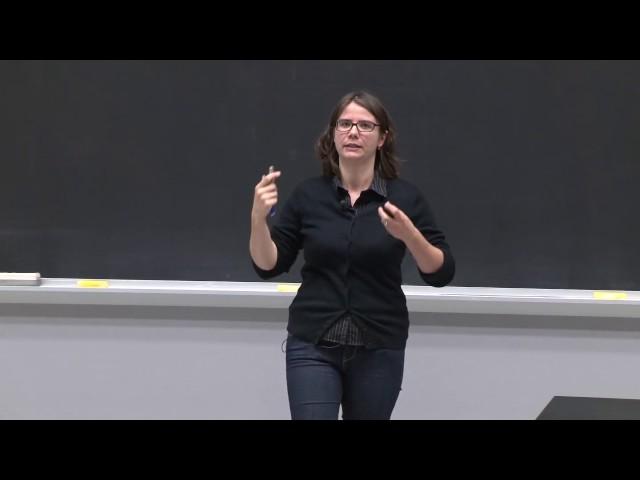
5. Tuples, Lists, Aliasing, Mutability, and Cloning
Комментарии:

I found something wrong which q=0 is right but the r = 4 is not true .
Ответить
Loved the Photo of Justin Bieber being credited to © Justin Bieber in the end 😂
Ответить
I thought python runs from up to down. Your lists mutability shows down to up.
Ответить
Thanks for the video. It really helps me to fully understand the difference between a tuple and a list.
Ответить
Sadly we never see where she is pointing to, makes it a bit more difficult to follow, showing her waiving her arm is useless.
Hope the latest videos produced by MIT fix this (if any), maybe some bright spark can solve it or solved it.
And give her some rubber bands to keep her shirt sleeves up ?

no idea what is going on when using laser pointer to point at the physical screen where couldn't see in this video.
Ответить
I'll make a comment on it, since for some reason this really confused me: why .sort() returns none. (If I get something wrong, feel free to correct me and I will edit this comment, I am new to coding.)
The reason that list.sort() and list.reverse() return None, while sorted(list) returns a list's values, is basically that the methods are completed by different means. Code that returns None is completed "in-place," which means that the original variable itself is not duplicated, only changed. Python does not want you to think that a new variable has been/could be created after running the method .sort() or .reverse() (or any other in-place method), and so it returns None. It is basically telling you that any method that is done in-place CANNOT generate a new variable because it has not duplicated the old variable.
Meanwhile, sorted(list) is creating a new list entirely, and so you can assign it to a new variable name. ( sortedList = sorted(originalList) )
So basically, don't assign in-place methods to any new variables.

Thanks for this! Mutable side effects are annoying! x_x
Ответить
Bad way to learn programming...
Ответить
This is very hard to follow. She's showing slides that we can see for only a few seconds. She then points at them, refer to them and says "this" a lot but we cannot see what she is pointing at anymore...
Ответить
Thank You very much!
Ответить
So why would I pay a ton of money for this?
Ответить
I have a confusion, If tuples are immutable how does nums = nums + (t[0],) work?
Ответить
So, if you make a variable, equal to another variable, you are creating an alias. So, if var1 = var2, then var1 points to the same memory address as var2, making it a pointer to var2. Coming from c++ it seems weird that when assigning var1 to var2, it makes a pointer, instead of a copy. And instead, having to specify when do you want a copy... But it's ok, as python's thing is being syntactically simple and it also reduces the garbage to collect, etc, etc.
Ответить
Dr Ana Bell is absolutely phenomenal at what she does. What an amazing explanation again. I can't believe MIT has such high quality content up there available for free.
Ответить
Great tutor and lessons however I would like a picture in picture of her and to be able to see what she is pointing at on the screen. hard to follow when you cannot see what she is pointing at.
Ответить
For the last L1, L2 question, I've tried it with the first code but got L1 = [2, 3]. Is that because Python has been updated to fix that issue??
Ответить
this video introduced Justin Bieber to me
Ответить
Why she's all time walking left right .. after 2-3 phrases she returns to her computer and camera man ... suck .i don't need to see her .. she's boring
Ответить
Obli is getting progress
Ответить
Mam is very beautiful
Ответить
Ana explains all the theory very clear. Already knew most of the python she explains but it still helped me understand the big picture of programming
Ответить
Good lectures , clear slides and Dr. Ana Bell very , very good professor .
Tanks MIT to give us thats extraordinarys open courses .

so Python knows to map min_n and max_n to min_year and max_year....?
Ответить
Thank you mit open course to provide us wonderful lectures .
🇺🇸 ❤ 🇮🇳

Thank you professor Bell
Ответить
Darn, a lot of this information would have been great to do the hangman assignment! I did it all with strings and it was a bit challenging and probably hard for another programmer to follow in some areas. Lists are awesome.
Ответить
Comparing the current course available on edx and this, I still prefer the full lecture length videos from Fall '16. It's a lot more compact but it's easier to stay focused.
Ответить
great video. python, while it's syntax is simple, that simplicity in some ways serves to detract from what is actually happening and how things are processed. It's more apparent when you compare python operations to something like that of c++, where you realize how much python does for you. Other than information hiding, it's a lovely language.
Ответить
Wonderful! learned a lot! (It would be great if the camera man focused on the slides when Dr.Bell was pointing at them.)
Ответить
FYI don’t use capital “L” as a name, or capital L for anything in python code, it’s not idiomatic python, use a more descriptive name, and avoid capital letters, especially single capital letters. I understand why they did it though, for an example you don’t need a long name and lowercase “l” is hard to discern from the number 1 with a lot of fonts. Get yourself a monospaced programming font like Hack to help!
Ответить
👍👍👍👍👍
Ответить
Thank you MIT for providing such invaluable content to the public! Thank you!
Ответить
It would be better if the Slide and the lecturer are split in a video
Ответить
In that last example, couldn't one iterate through the list backwards?
Ответить
That's the only thing I don't like about these videos...when the professor is calling attention to something on the board the camera person just keeps staring at the professor. Can we see what's she's referring to? It's kinda frustrating.
Ответить
Ah yes, when a concept is being explained the logical course of action is to quickly cut away from the slides.
Ответить
I ( we ) need a course from u just to define all these different words you use in most of ur analysis? ???
Ответить

























